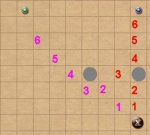Sammael
Adventurer
WotC published their alternative rules for hexes in Unearthed Arcana - here's the d20 SRD version:TwinBahamut said:KarinsDad, how exactly do larger than standard creatures work in hex systems? A medium size creature would be 1 hex, a large creature would be 3 hexes, and a huge creature would be 7 hexes, correct? How does it go from there?
http://www.d20srd.org/srd/variant/adventuring/hexGrid.htm

